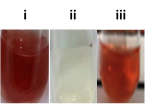
The development of smart screening technology kit (SST-Kit) for sorting cassava cultivars based on cyanide analysis
Luluil Maknun(1), Noerma Juli Azhari(2), Mike Nur Izzati(3), Rizal Nur Huda(4), Abdul Malik Bahrudin(5), Erliana Ginting(6), Hermin Sulistyarti(7*)
(1) Department of Chemistry, Faculty of Science, Brawijaya University, Malang 65145, Indonesia
(2) Department of Chemistry, Faculty of Science, Brawijaya University, Malang 65145, Indonesia
(3) Department of Chemistry, Faculty of Science, Brawijaya University, Malang 65145, Indonesia
(4) Department of Chemistry, Faculty of Science, Brawijaya University, Malang 65145, Indonesia
(5) Department of Chemistry, Faculty of Science, Brawijaya University, Malang 65145, Indonesia
(6) Indonesian Legumes and Tuber crops Research Istitute (ILETRI), Malang 65101, Indonesia
(7) Department of Chemistry, Faculty of Science, Brawijaya University, Malang 65145, Indonesia
(*) Corresponding Author
Abstract
Cyanides are deadly toxic substances commonly found in cassava root tuber. Higher content of cyanides causes bitter taste of the root tuber. Therefore, analysis of cyanide content has been used as one of criteria for bitterness in cassava. The substitute common method used for this purpose was organoleptic test that could lead to poisoning, or argentometry, which is complicated, time-consuming, and requires lots of reagents. Therefore, a fast, easy, and safe method is strongly demanded. In this work, a smart screening technology kit (SST-Kit) was developed using ninhydrin reagent. This simple, fast, and low-cost method can be applied in the field for the analysis of cyanide levels in cassava. This method was optimized to the concentration of sodium carbonate from 0.5 to 2.0% by measuring the red color intensity produced under various times of reading from 1 to 3 minutes and three sample preparation techniques. The optimum condition for SST-Kit to read the cyanides level was achieved under the condition of 0.5% of sodium carbonate with a time readout of 2 minutes, using grinding preparation technique followed by dilution. The SST-kit had been applied on cassava samples with the accuracy of more than 90%.
Keywords
Full Text:
PDFReferences
Abdalla, M. and M.F. Sofwan. 2007. Sequential injection spectrophotometric determination of cyanide, J. Flow Injection Anal., 24: 17 – 21.
Bradbury, J.H., S.V. Egan, and M.J. Lynch. 1991. Analysis of cyanide in cassava using acid hydrolysis of cyanogenic glucosides. J.Sci.Food Agric., 55:277-290.
Drochioiu, G., I. Mangalagiu, E. Avram, K. Popa, A.C. Dirtu and I. druta. 2004. Cyanide reaction with ninhydrin: elucidation of reaction and interference mechanisms. Anal. Sci., 20: 1443-1447.
Ginting, S., and Y. Widodo.2013.Cyanide reduction in cassava root product through processing and selection of cultivars in relation to food safety. Buletin Palawija. 25: 25-36.
Hlaing, A., K. Naing, S.S. Myint, and Y.M. Aung. 2011. Study on the reaction between ninhydrin and cyanide and its analytical applications. Universities Research J., 4: 283 - 300.
Jackson, R. and B. A. Logue. 2017. A review of rapid and field-portable analytical techniques for the diagnosis of cyanide exposure. Anal. Chim. Acta. 960: 18-39.
Mihaescu, I.M., G. Droichioiu. 2009. Cyanide reaction with ninhydrin : the effect of ph changes and uv-vias radiation upon the analytical results. Rev. Roum. Chim., 54: 841-845.
Nagaraja, P., M.S. Kumar, H.S. Yathirajan, J.S. Prakash. 2002. Novel sensitive spectrophotometric method for the trace determination of cyanide in industria effluent. Anal. Sci., 18:1027-1030.
Niu, Q., L. Lan, T. Li, Z. Guo, T. Jiang, Z. Zhao, Z. Feng and J. Xi. J. S. 2018. A highly selective turn-on fluorescent and naked-eye colorimetric sensor for cyanide detection in food samples and its application in imaging of living cells. Sensor Actuat. B-Chem., 276: 13-22.
Niu, Q., T. Sun, T. Li, Z. Guo and H. Pang. 2018. Highly sensitive and selective colorimetric/fluorescent probe with aggregation induced emission characteristics for multiple targets of copper, zinc and cyanide ions sensing and its practical application in water and food samples. Sensor Actuat. B-Chem., 266: 730-743.
Onyesom, I., P. Okoh and O.V. Okpokunu. 2008. Levels of cyanide in cassava fermented with Lemon Grass (Cymbopogon citratus) and the organoleptic assessment of its food products. World Appl. Sci. J., 4: 860-863.
Sundari, T., K. Hartojo, Sholihin and E. Ginting. 2000. Identification and characterization of cassava clones for good taste purposes. p.217–223. In A.A. Rahmiana, J. Soejitno, D.M. Arsyad, Heriyanto, Sudaryono, Suharsono and I.K. Tastra (eds). Bogor : Source Management of Legume and Tuber Crops. CRIFC. (in Indonesian).
Surleva, A., S. Bancila, E.V. Todorova. 2013. A study on ninhydrin reaction with weak acid dissociable cyanide and its application for toxic cyanide determination.Int. J. Environ. Anal. Chem., 2: 1 – 6.
Taylor, J., N. Roney, C. Harper, M.E. Fransen, and S. Swarts. 2006. Toxicological profile for cyanide. U.S. Department of Health and human services, https://stacks.cdc.gov/view/cdc/6950.
Yildiz, K., B. Dokuzeylul, R. Gonul and M. Erman. 2017. Cyanide poisoning in cattle. J. Dairy and Veterinary Sci., 4: 1-3.
Article Metrics
Refbacks
- There are currently no refbacks.
Ilmu Pertanian (Agricultural Science) ISSN 0126-4214 (print), ISSN 2527-7162 (online) is published by Faculty of Agriculture Universitas Gadjah Mada collaboration with Perhimpunan Sarjana Pertanian Indonesia (PISPI) and licensed under a Creative Commons Attribution-ShareAlike 4.0 International License.














